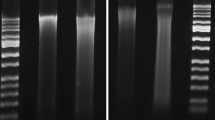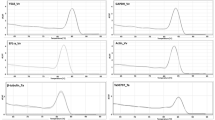Abstract
The high polysaccharide content of some plant species hinders the successful isolation of their DNA. As an alternative to the macro-extraction methods previously published for polysaccharide-rich plants, we present two techniques (STE/CTAB and HEPES/CTAB), which are performed in microcentrifuge tubes. These protocols are suitable for small amounts of silica gel-preserved plant tissue such as are commonly available from endangered plants. The critical step to remove polysaccharides was performing initial washes in either STE (0.25 M sucrose, 0.03 M Tris, 0.05 M EDTA) or HEPES (2% β-mercaptoethanol, 0.2% PVP, 0.1 M HEPES, pH 8.0) buffer. Precipitating the DNA at room temperature with isopropanol also aided in decreasing polysaccharide co-precipitation. Of the two protocols we present the STE/CTAB method has the advantages of being more cost-effective and avoiding the use of the hazardous chemical β-mercaptoethanol.
Similar content being viewed by others
Avoid common mistakes on your manuscript.
Obtaining DNA is the essential first step for many genetic studies. Many plant species present a variety of problems when attempting to isolate DNA, with polysaccharides one of the most frequently encountered problems (Varma et al. 2007). The high viscosity of polysaccharides causes pipetting difficulties, and they hinder downstream applications by interfering with the activity of enzymes such as restriction endonucleases, ligases and polymerases (Fang et al. 1992).
Our initial attempts to extract DNA from both fresh and silica gel-dried leaf tissue of the endemic New Zealand plant Entelea arborescens (Malvaceae) using a modified cetyl trimethyl ammonium bromide (CTAB) method (Doyle and Doyle 1990) that we had used with numerous other plant species were unsuccessful. Incubation in CTAB extraction buffer (2% CTAB, 1% PVP, 1.4 M NaCl, 100 mM Tris–HCl pH 8.0, 20 mM EDTA pH 8.0) produced an extremely viscous solution that was difficult to pipette and separate from the powdered leaf tissue. This solution would not homogenize with chloroform, even with vortexing. Attempts to obtain DNA from E. arborescens using a Qiagen DNeasy Plant mini kit were also unsuccessful. The Malvaceae is particularly known for containing species high in polysaccharides (Bayer et al. 1999) but they are also present in many other plant families, including the Brassicaceae (Kaufman et al. 1999), Fabaceae (Ribeiro and Lovato 2007), Asteraceae (Michiels et al. 2003), cacti (de la Cruz et al. 1997) and conifers (Crowley et al. 2003). In many species polysaccharides only become apparent when they co-precipitate with DNA following the addition of alcohol during later stages of the DNA extraction process (Cota-Sánchez et al. 2006). In contrast, polysaccharides were a problem during the first step of E. arborescens DNA extractions. Therefore, a successful extraction protocol for this species needs to first begin by removing these polysaccharides.
A number of DNA extraction methods have been developed to avoid the co-precipitation of polysaccharides, with the use of high concentrations of NaCl and/or CTAB popular (Varma et al. 2007). However, many of these methods use large quantities (≥1 g) of fresh plant tissue (e.g., de la Cruz et al. 1997; Kaufman et al. 1999; Michiels et al. 2003; Remya et al. 2004). Therefore, they are impractical when only small amounts of plant tissue are available; e.g., from threatened taxa or particularly small plants. Many of these methods also use large volumes of reagents (e.g., de la Cruz et al. 1997; Kaufman et al. 1999; Crowley et al. 2003; Michiels et al. 2003; Ghosh et al. 2009), thus increasing costs and necessitating the use of an ultracentrifuge. It is also often desirable to extract DNA from preserved samples, such as those collected in the field from distant locations, rather than from fresh tissue.
We aimed to develop an inexpensive, small-scale (i.e., performed in microcentrifuge tubes) method for isolating DNA from silica gel-dried leaf material containing polysaccharides. We started by scaling down a number of existing macro-extraction methods developed for polysaccharide-rich plants, as well as trialling the micro-scale sorbitol method of Drábková et al. (2002). These protocols were tested on Entelea arborescens, a species that is threatened in southern parts of its range (Sawyer 2004).
Silica gel-dried young leaf tissue was prepared for use with all methods using step 1 in Table 1. The scaled down methods of Barnwell et al. (1998), Remya et al. (2004) and Sharma et al. (2002), and the sorbitol method of Drábková et al. (2002), yielded little or no DNA. We also trialled two methods (Tables 1 and 2), both of which use initial wash steps, followed by a modified CTAB protocol: the STE/CTAB method, with an STE wash step modified from Kaufman et al. (1999); and the HEPES/CTAB method with a HEPES wash step adapted from Setoguchi and Ohba (1995). Using these two methods we were able to successfully isolate significant amounts of DNA from Entelea arborescens (Table 3). However, for both methods the DNA extracts were viscous, and the A260/230 absorbance ratios were low (Table 3) indicating that contaminating polysaccharides had not been completely eliminated. We found that precipitating the DNA with room temperature, rather than ice-cold, isopropanol did result in slightly decreased polysaccharides. For the STE/CTAB method we found that increasing the NaCl concentration in the CTAB buffer from 1.4 to 4 M yielded no DNA and increasing the sucrose to 0.5 M or adding 4 M NaCl to the STE buffer did not reduce polysaccharide co-precipitation.
To assess whether the polysaccharides inhibited enzymatic reactions we conducted PCR amplification and AFLP DNA-fingerprinting for both STE/CTAB and HEPES/CTAB extracts. PCR of the chloroplast rps4 gene and rps4-trnS intergenic spacer in Entelea arborescens was performed as described in Shepherd et al. (2007) for 106 STE/CTAB and 25 HEPES/CTAB DNA extracts. 1 μl of 1:70 diluted DNA extract was included in each PCR reaction. This region successfully amplified in 102 of our STE/CTAB DNA extracts (Fig. 1a) and all of the HEPES/CTAB extracts, although further dilution (up to 1:200) was required for amplification from a few samples.
a Agarose gel image showing amplification of the chloroplast rps4 gene and rps4-trnS intergenic spacer (lanes 2–6, lane 1 is the negative PCR control) and EcoR1 + Mse1 restriction digests (lanes 7–12) from STE/CTAB extracted Entelea arborescens. Selected band sizes of the ladder are shown in kilobases. b Screenshot from Genemapper (Applied Biosystems) showing a portion of the AFLP profiles of two E. arborescens samples (1 and 2) extracted using two methods (1-a and 2-a extracted with the STE/CTAB method and 1-b and 2-b extracted with HEPES/CTAB). All DNA extracts were amplified with the selective primers PET-Eco-AAG and Mse-CAG
AFLP was performed as described in Perrie and Shepherd (2009) for eight Entelea arborescens samples, each extracted with both the STE/CTAB and HEPES/CTAB methods. The AFLP profiles for each sample were very similar both within and between extraction methods (Fig. 1b), indicating that the DNA templates were producing consistent results.
In conclusion, we present two DNA micro-extraction methods that are successful with the polysaccharide-rich Entelea arborescens. We have also found that the STE/CTAB method improved the quality of DNA extracted from inflorescence tissue of Dactylanthus taylorii (Balanophoraceae), another species with recalcitrant DNA. For extracting DNA from other polysaccharide-rich species we suggest first attempting the STE/CTAB method. This method does not use expensive HEPES making it around four times cheaper than the HEPES/CTAB method. A further advantage of the STE/CTAB method is its avoidance of the hazardous chemical chemical β-mercaptoethanol.
References
Barnwell P, Blanchard AN, Bryant JA, Smirnoff N, Weir AF (1998) Isolation of DNA from the highly mucilaginous succulent plant Sedum telephium. Plant Mol Biol Reptr 16:133–138
Bayer C, Fay MF, De Bruijin AY, Savolainen V, Morton CM, Kubitizki K, Alverson WS, Chase MW (1999) Support for an expanded family concept of Malvaceae within a recircumscribed order Malvales: a combined analysis of plastid atpB and rbcL DNA sequences. Bot J of Linnean Soc 129:267–303. doi:10.1111/j.1095-8339.1999.tb00505.x
Cota-Sánchez JH, Remarchuk K, Ubayasena K (2006) Ready-to-use DNA extracted with a CTAB method adapted for herbarium specimens and mucilaginous plant tissue. Plant Mol Biol Reptr 24:161–167
Crowley TM, Muralitharan MS, Stevenson TW (2003) Isolating conifer DNA: a superior polysaccharide elimination method. Plant Mol Biol Reptr 21:97a–97d
de la Cruz M, Ramirez F, Hernandez H (1997) DNA isolation and amplification from cacti. Plant Mol Biol Reptr 15:319–325
Doyle JJ, Doyle JD (1990) Isolation of plant DNA from fresh tissue. Focus 12:13–15
Drábková L, Kirschner J, Vlček C (2002) Comparison of seven DNA extraction and amplification protocols in historical herbarium specimens of Juncaceae. Plant Mol Biol Reptr 20:161–175
Fang G, Hammer S, Grumet R (1992) A quick and inexpensive method for removing polysaccharides from plant genomic DNA. BioTechniques 13:52–56
Ghosh R, Paul S, Ghosh SK, Roy A (2009) An improved method of DNA isolation suitable for PCR-based detection of begomoviruses from jute and other mucilaginous plants. J Virol Methods 159:34–39. doi:10.1016/j.jviromet.2009.02.020
Kaufman B, Richards S, Dierig DA (1999) DNA isolation method for high polysaccharide Lesquerella species. Ind Crop Prod 9:111–114. doi:10.1016/S0926-6690(98)00021-1
Michiels A, Van den Ende W, Tucker M, Van Riet L, Van Laere A (2003) Extraction of high-quality genomic DNA from latex-containing plants. Anal Biochem 315:85–89. doi:10.1016/S0003-2697(02)00665-6
Perrie LR, Shepherd LD (2009) Reconstructing the species phylogeny of Pseudopanax (Araliaceae), a genus of hybridizing trees. Mol Phylogenet Evol 52:774–783. doi:10.1016/j.ympev.2009.05.030
Remya R, Syamkumar S, Sasikumar B (2004) Isolation and amplification of DNA from turmeric powder. Br Food J 106:673–678. doi:10.1108/00070700410558201
Ribeiro RA, Lovato MB (2007) Comparative analysis of different DNA extraction protocols in fresh and herbarium specimens of the genus Dalbergia. Genet Mol Res 6:173–187
Sawyer JWD (2004) Plant conservation strategy: Wellington Conservancy (excluding Chatham Islands) 2004–2010. Department of Conservation, Wellington
Setoguchi H, Ohba H (1995) Phylogenetic relationships in Crossostylis (Rhizophoraceae) inferred from restriction site variation of chloroplast DNA. J Plant Res 108:87–92
Sharma AD, Gill PK, Singh P (2002) DNA isolation from dry and fresh samples of polysaccharide-rich plants. Plant Mol Biol Reptr 20:415a–415f
Shepherd LD, Perrie LR, Brownsey PJ (2007) Fire and ice: volcanic and glacial impacts on the phylogeography of the New Zealand forest fern Asplenium hookerianum. Mol Ecol 16:4536–4549. doi:10.1111/j.1365-294X.2007.03451.x
Varma A, Padh H, Shrivastava N (2007) Plant genomic DNA isolation: an art or a science. Biotechnol J 2:386–392. doi:10.1002/biot.200600195
Acknowledgments
This study was funded by the New Zealand Marsden Fund (contract number MAU0709). We thank Peter Lockhart and Leon Perrie for comments on the manuscript.
Author information
Authors and Affiliations
Corresponding author
Rights and permissions
About this article
Cite this article
Shepherd, L.D., McLay, T.G.B. Two micro-scale protocols for the isolation of DNA from polysaccharide-rich plant tissue. J Plant Res 124, 311–314 (2011). https://doi.org/10.1007/s10265-010-0379-5
Received:
Accepted:
Published:
Issue Date:
DOI: https://doi.org/10.1007/s10265-010-0379-5





